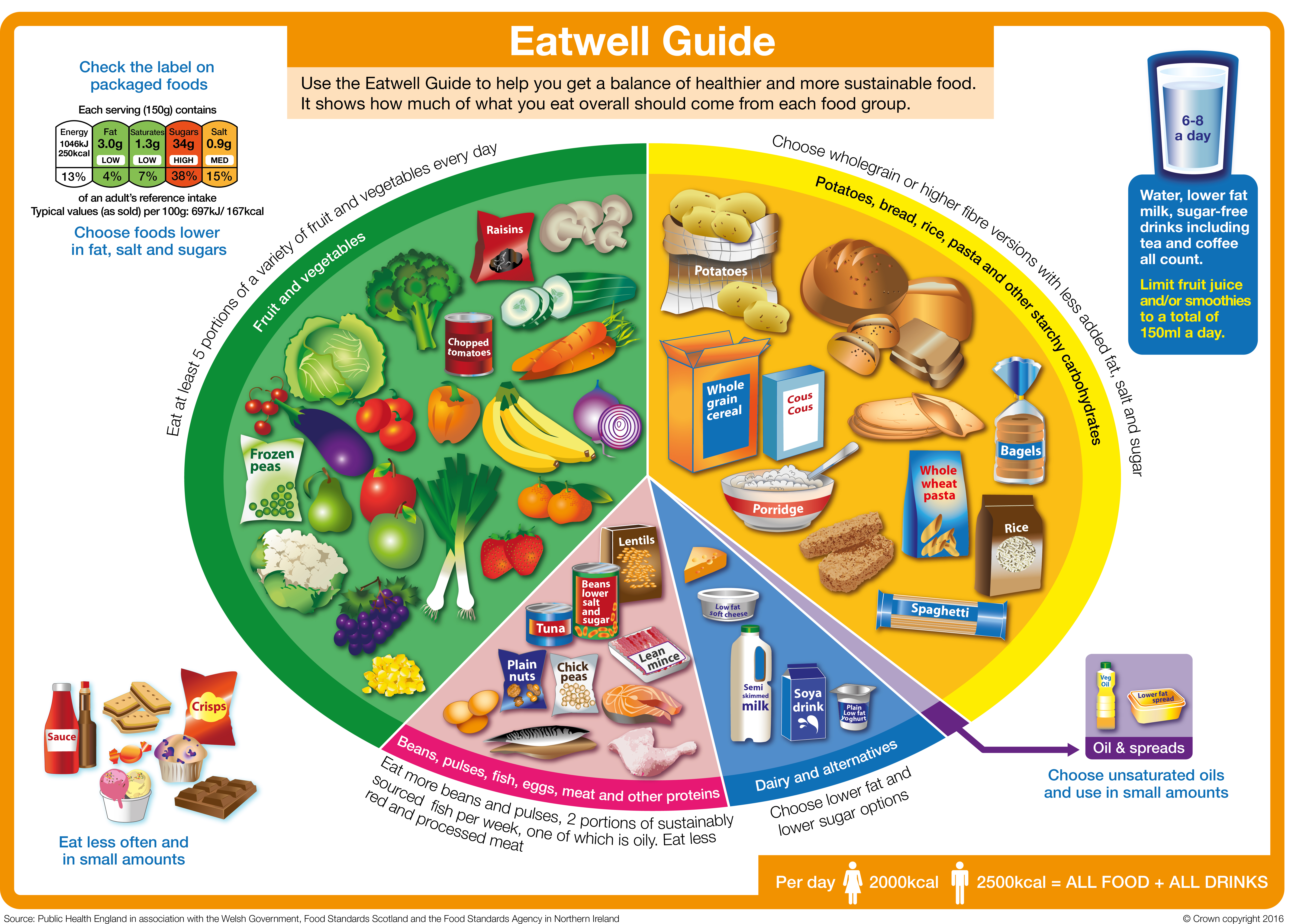Diet and Blood Pressure
Introduction
You have been asked to adopt a healthy balanced diet. A diet high in salt has been shown to increase blood pressure. Adopting healthy eating habits has been shown to lower blood pressure. A diet high in fruit and vegetables which are rich in fibre, along with a reduction in salt intake has been shown to reduce blood pressure.
Your doctor may prescribe tablets to help lower your blood pressure. Dietary changes are important as they can improve the effect of, or remove the need for medications.
How can you help lower your blood pressure?
- Follow a healthy balanced diet, reduce saturated fat and opt for rapeseed or olive oil.
- Aim for your fruit and vegetable intake to be at least 5 portions per day.
- Reduce your salt intake.
- Lose weight if you are overweight – even a small reduction of 5% can help make a
difference. - Increase exercise levels.
- Reduce your alcohol consumption.
- Stop smoking.
Eat more fruit and vegetables
Fruit and vegetables are good sources of vitamins and minerals.
Healthy Eating Guidelines recommend eating a minimum of five portions of fruit and vegetables per day. The Blood Pressure Association UK recommends that we should be aiming for five portions per day.
More information is available below and on the NHS website: www.nhs.uk/live-well/eat-well/food-guidelines-and-food-labels/the-eatwell-guide/

What is a portion?
- 1 medium fruit, i.e. apple, banana, pear
- 2 small fruits, i.e. plums, satsumas, kiwi
- ½ large fruit, i.e. mango, avocado
- Handful of grapes or strawberries
- 1 heaped teaspoon of dried fruit
- 1 dessert bowl of mixed salad
- 2 tablespoons of vegetables
- 1 glass (150ml) of fruit/vegetable juice (only 1 portion of juice can be included per day no matter how much you drink).
Bread, other cereals and potatoes
These are carbohydrate foods and are a good source of energy and should be included at every meal. Try to choose higher fibre varieties wherever possible as these are more filling and will help to reduce snacking between meals.
Choose:
- Wholemeal/granary breads
- Wholemeal pasta
- Basmati rice
- Wholegrain cereals, e.g. porridge, Weetabix, Shredded Wheat
- Use brown/wholemeal flour in cooking and baking.
Milk and dairy foods
These foods are great sources of calcium which helps to keep bones and teeth healthy.
They are also good sources of protein. For vegans include calcium enriched soy, oat and nut milks.
It is important to eat two to three servings from this group per day.
Try choosing low fat, reduced fat and diet varieties if aiming to lose weight or control cholesterol levels.
Meat, fish and alternatives
Meat, poultry, fish, eggs, beans, pulses, tofu, and nuts are all sources of protein necessary for growth and repair but they can be high in fat. It is important to limit foods from this group to two to three servings per day. Try to use low fat cooking methods wherever possible, i.e. steaming, grilling, poaching, and baking.
Fatty and sugary foods
These foods contribute to weight gain. Reducing animal fats (saturated fat) and choosing unsaturated fats such as olive, rapeseed and vegetable oils can help to reduce cholesterol levels and the risk of heart disease.
- Choose ‘sugar free’ and ‘reduced sugar’ varieties
- Choose low fat and reduced fat varieties.
Keeping foods high in sugar and fat to a minimum in the diet can help you to lose weight.
Facts about salt
75% of salt is hidden in foods. Processed foods and convenience foods have a high salt content, e.g:
- ready-made meals
- savoury snacks
- tinned or packet products
- processed meats.
The easiest way to reduce your salt intake is to avoid adding to food in cooking or at the table.
How to reduce the salt in your diet
- keep salt in cooking to a minimum
- do not use salt at the table
- avoid foods high in salt and choose suitable alternatives
- look at food labels on processed foods and convenience foods as these have a high salt content.
Food labelling
When checking food labels you should look at the section ‘per 100g’ serving.
| LOW Eat Freely | MEDIUM Eat only occasionally | HIGH Avoid these completely | |
| SODIUM (per100g/ml of food) | 0.1g or less | 0.1-0.6g | 0.6g or more |
| SALT (per100g/ml of food) | 0.3g or less | 0.3-1.5g | 1.5g or more |
Salt substitutes
Salt substitutes, e.g.; Lo Salt, Pan Salt, rock salt, pink salt are not recommended for patients with Kidney Disease as they are high in potassium in addition to some sodium.
Foods to avoid
- Meats: Bacon, ham, sausages, corned beef, tongue, luncheon meat, Spam, beef burgers. All tinned meats.
- Fish: Smoked fish or shellfish, e.g. kippers, yellow (smoked) haddock, cockles, prawns, mussels. Fish tinned in brine. Anchovies, salt fish.
- Spreads: Butter, fish and meat pastes. Pâté. Sandwich spreads. Peanut butter.
- Cheeses: Limit cheese, e.g. Cheddar, Edam, Stilton and Brie to 2oz per week. Cheese spreads.
- Snacks: Salty savoury biscuits, e.g. Ritz, Tuc, salted and flavoured crisps. Salted and dry roasted nuts. Pot Noodles.
- Cereals: All Bran, Cornflakes, Rice Krispies.
- Miscellaneous: Marmite, Bovril, Oxo. Ready-made meals, meat pies, pasties, pizza, take-away. Tinned vegetables and pulses in salted water. Packet and tinned soups.
Foods to have instead
- Beef, lamb, pork, chicken, turkey
- Unsmoked fish, e.g. plaice, cod, haddock, salmon, tinned tuna in spring water
- Jam, marmalade, eggs, margarine and low fat spreads
- Cream cheese, cottage cheese
- Cream crackers, water biscuits
- Unsalted crisps or nuts
- Weetabix, porridge, puffed wheat, shredded wheat
- Home-made pies and pasties, homemade soup
- Tinned vegetables and pulses in unsalted water.
Flavourings to be avoided
- Marmite, Bovril, Oxo, gravy salt, soy sauce
- Celery salt, garlic salt, horseradish, onion salt
- ‘Season all’ and ‘jerk’ seasoning.
Flavourings in moderation
1-2 teaspoons of pickles, chutney, Piccallili, Worcestershire sauce, ketchup, brown sauce, BBQ sauce, mayonnaise or salad cream.
Stock cubes can be used sparingly to make soups, stocks and gravy. Very Low salt stock cubes should be used, for example:
- ‘Boots baby organic stock cubes’ (0.01g salt/100ml)
- ‘Kallo very low salt organic stock cubes’ (0.1g salt/100ml)
- ‘Oxo reduced salt stock pots’ (0.5g salt/100ml) or cubes (0.6g salt/100ml).
Alternative salt free flavourings
To make food cooked without salt taste more interesting and less bland, try to use some alternative flavourings listed below:
- Basil
- Nutmeg
- Bay leaf
- Onion
- Cardamom
- Oregano
- Chilli powder
- Paprika
- Chives
- Parsley
- Cinnamon
- Pepper (green/red)
- Cumin
- Pepper (black/white)
- Coconut
- Pimento pepper
- Coriander
- Peppermint oil
- Curry powder
- Rosemary
- Dill
- Saffron
- Garlic
- Sage
- Garam
- Masala Sesame seeds
- Ginger
- Tarragon
- Lemon juice
- Thyme
- Marjoram
- Turmeric
- Mint
- Vanilla extract
- Mustard powder
- Vinegar
The above herbs and spices may be used fresh, dried or frozen.
Some ideas for using flavourings
- Apple and cinnamon – with pork and fish
- Bouquet garni – in stews and casseroles
- Curry powder – to make meat or vegetable curry
- Nutmeg (grated) – in mashed potatoes
- Chilli powder – to make meat or vegetable chilli
- Mint – with lamb or new potatoes
- Lemon juice – on fish or salads
- Garlic (not garlic salt) – on meat, in sauces and casseroles
- Rosemary – with lamb.
How can you lose weight – Check your BMI, Weight / Height (British Heart Foundation)
The best way to lose weight is to follow a healthy balanced diet.
Eating a healthy diet contains less fat and sugar and will help you lose weight gradually.
A steady weight loss of 1-2lbs per week is ideal.
Increase your exercise levels – aim for 30 minutes of aerobic or cardiovascular exercise three to five times a week, for example:
- Aerobic classes
- Brisk walking
- Swimming
- Cycling.
If you would like further input/support to help you lose weight please discuss this with your GP who will advise on local weight management services/sessions available to you.
Alcohol
If you drink alcohol then add up your alcohol intake in ‘units’ over a typical week. One unit of alcohol is:
- A half pint of normal strength beer (4%)
- A small (125mls) glass of wine (11%)
- A pub measure (25mls) of spirits (40% alcohol or 80% proof).
The recommended alcohol intake is:
- reducing your intake to below 14 units per week
- spread these units evenly throughout the week and no more than 2 units per day
- it is a good idea to have several alcohol free days per week.
Contact numbers
We hope that you have found this information useful. If you have any questions or are worried about anything, please speak to the following Dorset County Hospital staff:
Renal dietitians: 01305 255377 or email renaldietitians@dchft.nhs.uk
Useful websites
Blood Pressure UK
www.bloodpressureuk.org
The British and Irish Hypertension Society
www.bihsoc.org
The DASH Diet
www.dashdiet.org
Public Health England
www.gov.uk
British Heart Foundation
www.bhf.org.uk
About this leaflet
Author: Yvonne Bradburn, Renal Dietitian
Written: February 2019
Approved: March 2019
Review date: March 2022
Edition: 1
Acknowledgment to University Hospitals Birmingham NHS Foundation Trust.
If you have feedback regarding the accuracy of the information contained in this leaflet, or if you would like a list of references used to develop this leaflet, please email patientinformation.leaflets@dchft.nhs.uk
Print leaflet